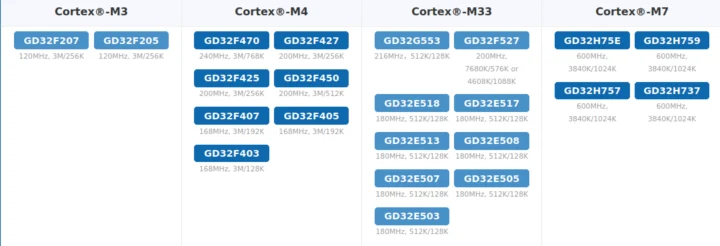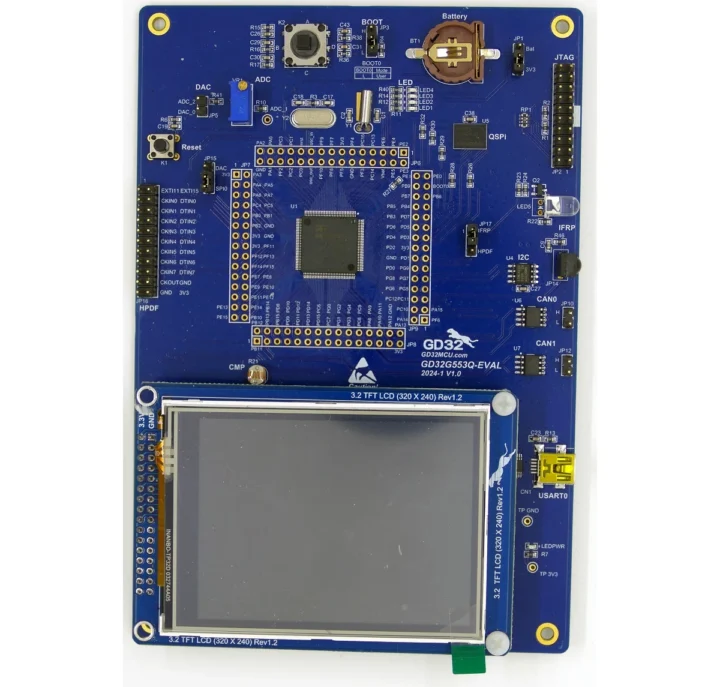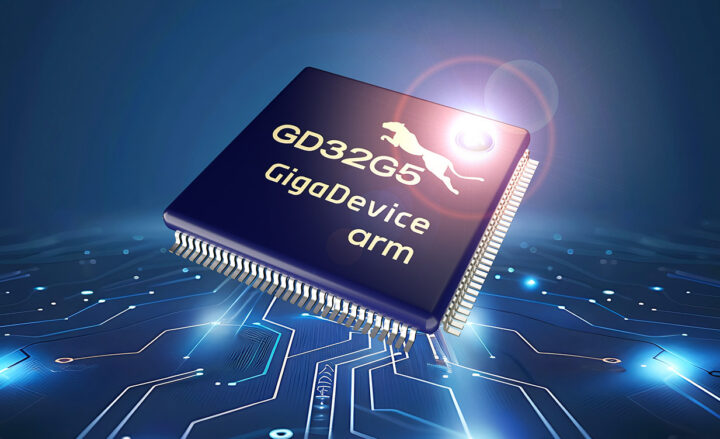Starting with the GD32G553 SKUs, the 216 MHz GigaDevice GD32G5 high-performance Arm Cortex-M33 microcontroller family features 256KB to 512KB of embedded Flash with dual-bank Flash support, 128KB of SRAM, and a range of hardware accelerators including a DSP, single-precision FPU, a trigonometric function accelerator (TMU), and other hardware acceleration units, filter algorithms (FAC) and Fast Fourier Transform (FFT).
Designed for industrial applications, the GD32G5 microcontrollers also offer a wide range of digital and analog interfaces and enhanced security capabilities suitable for digital power systems, charging stations, energy storage inverters, frequency converters, servo motors, and optical communication.
GigaDevice GD32G5 specifications:
- MCU Core – Arm Cortex-M33 Armv8-M core clocked at up to 216MHz with DSP instruction set and single-precision FPU; up to 316 DMIPS, CoreMark score: 694.
- Memory/Storage
- 128KB SRAM (80KB SRAM0 + 16KB SRAM1 + 32KB TCMSRAM)
- 256KB to 512KB on-chip flash, QSPI interface for external storage
- External memory controller (EXMC) for SRAM, PSRAM, ROM, and NOR Flash.
- Accelerators
- CRC – CRC calculation unit
- CLA – Configurable logic array
- TMU – Trigonometric math unit
- FAC – Filter arithmetic accelerator
- FFT – Fast Fourier transform
- Peripherals
- Up to 107x GPIOs
- 3x USART, 2x UART
- 3x CAN FD buses
- 4x I2C, 3x SPI
- Analog
- Up to 4x 12-bit ADC with up to 42 channels
- 8x 12-bit DAC
- Up to 8x comparators
- Timers
- 5x 16-bit general-purpose timers
- 2x 32-bit general-purpose timers
- 3x 16-bit advanced timers
- 2x 16-bit basic timers
- 1x HRTIMER (High-resolution timer)
- 1x LPTIMER (Low-power timer)
- Systick
- 2x Watchdog
- 1x RTC
- TRIGSEL – Trigger selection controller
- Security
- 2KB of OTP (One-Time Programmable) storage
- Flash/SRAM region supports ECC (Error Correction Code)
- Built-in hardware encryption and decryption modules supporting DES, Triple DES, and AES algorithms (CAU – Cryptographic acceleration unit)
- True Random Number Generator (TRNG)
- Safety – System-level IEC 61508 SIL2 functional safety standard
- Supply Voltage – 1.71V to 3.6V
- Packages – QFN48, LQFP48, LQFP64, LPFP80, WLCSP81, LQFP100, LQFP128
- Temperature Range – –40°C to +105°C
The GD32G5 (GD32G553) product lineup is currently comprised of 14 models offered in seven different package types and with either 256KB or 512KB flash.

It’s far from the first Cortex-M33 high-performance microcontroller from GigaDevice and we previously wrote about the GD32E5 and GD32F5 family for respectively motor/industrial control and industrial applications with high-memory requirements, as well as the GD32W515 Cortex-M33 wireless SoC.
While searching for differentiating features for the GD32G5, I noticed others are clocked at up to 180/200 MHz, but the new family clocks up to 216 MHz, and it also comes with a greater number of analog units and channels with up to four 12-bit ADCs (42 channels max) and eight 12-bit DAC, as well as a range of accelerators.

Software development is done through the GD32 Embedded Builder IDE and tools like GD-LINK and the “GD32 All-In-One Programmer programming” tool. The company also launched development boards such as the GD32G553Q-EVAL and GD32G553R-EVAL full-feature evaluation boards, as well as the GD32G553V-START, GD32G553M-START, and GD32G553C-START entry-level learning kits. I could not find information about the development boards on the GigaDevice website, but Segger has some limited information.
GigaDevice says GD32G5 MCU samples and development boards are available now (through distributors), and mass production is scheduled for next month (December 2024). Additional information may be found on the product page and in the press release.
Thanks to TLS for the tip.

Jean-Luc started CNX Software in 2010 as a part-time endeavor, before quitting his job as a software engineering manager, and starting to write daily news, and reviews full time later in 2011.
Support CNX Software! Donate via cryptocurrencies, become a Patron on Patreon, or purchase goods on Amazon or Aliexpress





